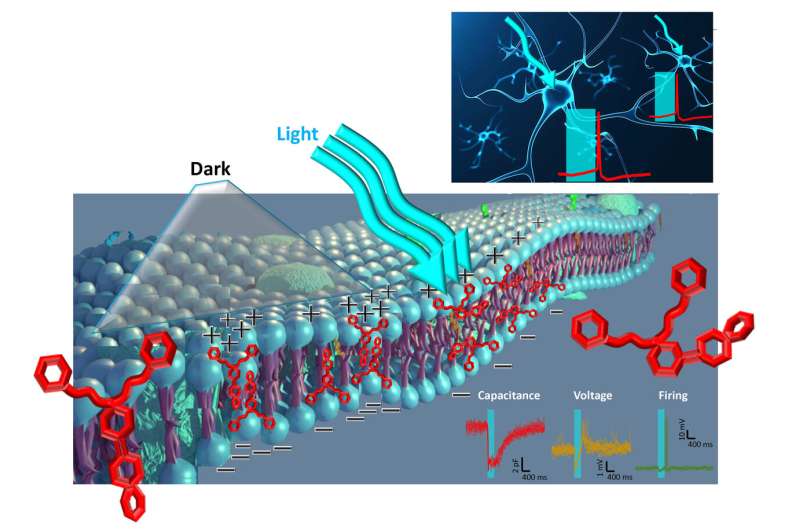February 21, 2020 feature
A light-sensitive compound enables heatless membrane modulation in photoswitches

Optical technologies that can be used to modulate neuronal activity are opening up exciting possibilities for research in neuroscience and biology. Optical tools allow neuroscientists to excite and inhibit neurons or areas of the brain at will. They can thus be used to investigate the function of specific brain circuits or regions, as well as to identify new potential treatments for neurological and psychiatric diseases.
The generation of tethered azobenzene photoswitches targeted at membrane bilayers or linked to ion channels is a pioneering optical technique that could further aid the study of the human brain. This technique, however, particularly when implemented at high light intensities, can lead to a considerable increase in temperature and can thus be harmful to neurons when used repeatedly.
To overcome this limitation, researchers at the Italian Institute of Technology (IIT) in collaboration with Politecnico di Milano, have recently created a new light-sensitive azobenzene compound, dubbed Ziapin2, which can be used to build photoswitches that do not increase in temperature when irradiated with visible light. This new compound, introduced in a paper published in Nature Nanotechnology, partitions into the plasma membrane with a high stability, enabling its thinning and an increased capacitance at a steady state.
"Our study was inspired (or bio-inspired) by two observations," Guglielmo Lanzani, one of the researchers who carried out the study, told TechXplore. "The first is that by and large nature captures light in living cells using photochromic molecules (e.g. retinal in retina photoreceptors). The second is that perturbation of the neuron membrane and particularly a change in electrical capacitance (the ability to store charges) leads to cell excitation, as observed by heating up the cell."
Photochromic molecules, such as the azobenzene compound engineered by Chiara Bertarelli, Guglielmo Lanzani and Fabio Benfenati, can change shape after they absorb light. This change also affects some of their properties, including their steric hindrance (i.e., the volume they occupy), color and electrical properties.
When applied to a membrane, this characteristic allows photochromic molecules to act as mechanical switches or springs, modulating the membrane's thickness upon absorbing light and thus changing its electrical capacitance. This in turn enables a series of phenomena, ultimately leading to an action potential in neurons.
"The methods used in our study allowed us to obtain a non-thermal stimulation mechanism for inducing light sensitivity in living cells and tissue," Lanzani explained. "Our approach is also non-genetic (avoids gene therapy) and non-covalent (avoids permanent chemical modifications of the cell). In other words, it is a minimally invasive tool."
When they applied millisecond pulses of visible light to neurons loaded with the compound they created, Benfenati, Lanzani and their colleagues observed a resulting transient hyperpolarization, shortly followed by a delayed depolarization that ultimately triggered the firing of action potentials. These effects were found to be persistent and the researchers were able to elicit them in vivo for up to 7 days in a row.
"The main achievement of our study is that we were able to stimulate neurons without optogenetic manipulations and without interfering directly with membrane ion channels," Benfenati told TechXplore. "We did this merely by prompting a transient deformation of the membrane that makes neurons electrically more stable in the dark and is released under light stimulation, evoking action potential firing."
Ziapin2, the compound introduced by Lanzani, Benfenati, Bertarelli and their colleagues, enables the modulation of membrane electrical capacitance in the millisecond timescale, without causing changes in temperature. In the future, it could be used to develop photoswitches for neuroscience research that are less harmful to neurons.
"Our plans for further research are twofold," Benfenati said. "On the one side, we plan to boost the application of Ziapin to excite retinal circuits in experimental models of retina degeneration or challenge diseased brain circuits. On the other side, we are looking for Ziapin variants that are more water soluble (and thus can be more safely administered) and that stay in the membrane for longer times."
More information: Mattia Lorenzo DiFrancesco et al. Neuronal firing modulation by a membrane-targeted photoswitch, Nature Nanotechnology (2020). DOI: 10.1038/s41565-019-0632-6
© 2020 Science X Network





















